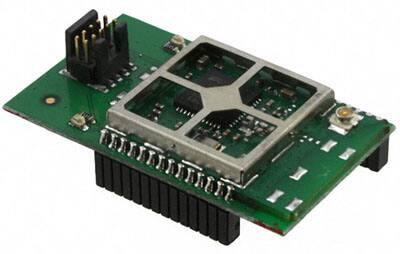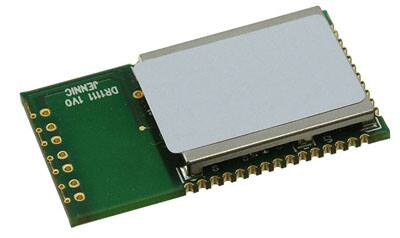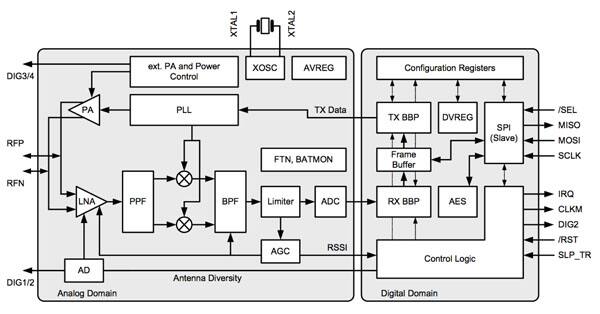Understanding the Benefits of Using ZigBee® for Wireless Lighting Control
投稿人:DigiKey 欧洲编辑
2013-06-11
Introduction and product focus
The market for lighting control devices in commercial buildings is forecast to double from 2010 to 2017, when IMS Research projects annual shipments will have reached 61.6 million devices. Reducing energy consumption in order to meet increasingly rigorous energy legislation is one of the biggest drivers for this growth, with the US Department of Energy recognizing that lighting accounts for 25.5% of a commercial building’s energy usage. While the US may lead with energy legislation and associated incentive programs for the installation of lighting controls, other countries in Europe and elsewhere are seeing an uptake in such systems as building owners seek to reduce their own consumption.
The currently installed base of lighting control systems uses both wired and wireless connectivity. For wireless communications, the most widely used technology is the 802.15.4 standard, which defines a low-rate, wireless personal area network (LR-WPAN) but is also the basis for the ZigBee® communications protocol. To date, many systems have deployed proprietary protocols but more and more companies, like building automation company Daintree Networks and key lighting supplier Philips Lighting Systems, are promoting the need for interoperability through adopting standard solutions like ZigBee®.
This article will examine the benefits of ZigBee® and its mesh topology as the wireless technology of choice for lighting control. More specifically, it will look at a number of ZigBee® transceiver solutions from leading suppliers; the EM351 system-on-chip from Silicon Labs, the Jennic JN5148-001 module from NXP and the separate radio and MCU solution from Atmel (AT86RF231 and ATMEGA2560); to see how these contribute to the wider ecosystem.
Understanding the standards
The word ZigBee® is rapidly becoming another of those brand names like Hoover, Sellotape, and even Google that have become nouns and verbs, referring to generic products and actions; respectively a vacuum cleaner, clear adhesive tape, and searching the Internet. ZigBee® of course comes from the ZigBee® Alliance, a non-profit association formed in 2002 to provide open wireless networking standards focused on monitoring, control and sensor applications. The Alliance’s activities are very much determined by its members, which come from all around the world and include large and small companies, public bodies / government agencies, universities, and other interested parties. Consequently, a number of standards have been formulated to address the needs of specific markets and applications such as: ZigBee® Building Automation, ZigBee® Remote Control and more recently ZigBee® Light Link, a standard designed to provide LED lighting controls for consumer products.
The prime purpose of the ZigBee® standards is to provide equipment manufacturers with an open-source specification that enables them to develop interoperable products. As such, it is essential to understand what the standards cover and, just as importantly, what they do not cover. Networking, whether wired or wireless, is mostly based on the OSI model, which defines seven layers from the physical layer through to the application layer. ZigBee® defines networking protocols that operate from layer 3 upwards but does not define layers 1 and 2. Instead, it relies on 802.15.4, one of the IEEE’s 802.15 groups of standards for wireless personal area networks (WPAN), to do this. This is often a source of confusion as devices that solely implement 802.15.4 may be referred to as ZigBee® transceivers when strictly they are not implementing any specific ZigBee® function, and are probably just as applicable to other low data rate WPAN applications supported by 802.15.4.

Referring to Figure 1, the physical layer (layer 1) of the OSI model deals with the communication medium, in the case of a wireless link, it defines operating characteristics such as frequency, modulation and power level. The media access control (MAC) layer (layer 2, also known as the data link layer) defines how the data is formatted and handled. 802.15.4 was designed for operation in the ISM (industrial, scientific & medical) radio bands, which include 868 MHz in Europe and 915 MHz in the USA and Australia, but it is the worldwide 2.4 GHz ISM band that is most widely used and consequently supported by the majority of commercial radio modules and integrated circuits.
ZigBee® protocols operate in the network layer (layer 3) and application layer (layer 7) and avoid some of the complexities of other WPAN standards like Bluetooth (802.15.1) to deliver a low-latency solution. This allows devices to remain in a low-power sleep mode most of the time while still being able to respond quickly when required – exactly what is needed for control and monitoring applications. One of the key areas in which ZigBee® uses these upper network layers is in expanding the basic peer-to-peer connectivity of 802.15.4 to provide a full mesh networking capability as discussed further below.
Lighting control - why wireless and why a mesh network?
As noted in the introduction, lighting accounts for over a quarter of the total energy usage in commercial buildings. The adoption of energy-saving LED lighting technology is one way to reduce costs, but clearly even greater savings are possible by turning lights off when not needed, and optimizing light levels to suit the working environment and the task in hand. Suitable controls are the key to reducing energy consumption and, for commercial buildings particularly, this requires a baseline of automatic controls. These avoid depending on fallible human beings to switch lights off at the end of the day or when rooms or other office areas are no longer occupied. Timers, perhaps in conjunction with door entry/exit controls, can take care of out-of-hours operation. Motion detection, using the all-too-familiar PIR sensor, is the most common method for activating lighting based on occupancy, with lights being dimmed or turned off after a pre-set period with no activity detected.
The use of ambient light sensors (often referred to as photo-sensors) is not just confined to security and other external lighting applications. These devices can be also be used very effectively to balance natural and artificial lighting in buildings where windows provide adequate levels of light during the daytime. Then, when conditions are less bright at either end of the day, or for internal locations not so close to a window, the levels of interior light can be raised to compensate. This approach to energy saving has even coined a new name – daylight harvesting. Another benefit from turning lights off when not required is the potential for further energy saving in buildings where air-conditioning is required to provide a comfortable working environment - even the most efficient LED lights still generate heat.
Having established a framework of automatic controls, there will always be a requirement to override default conditions with manual switches/dimmers, remote controls or through access to the programming system. Sensors should be located where they are needed to be most effective, having controls where they are most convenient for users. This creates a distributed system of devices that both need to interact with one another and communicate with a centralized control system that monitors activity and provides the means for measuring and displaying or reporting energy usage. Connecting these devices poses a challenge for businesses, which have previously been hesitant to adopt lighting controls because of their perceived complexity and cost. Wireless technology overcomes these objections by eliminating the need for dedicated control wiring and particularly the cost of installing or retrofitting it. Wireless solutions also provide flexibility and scalability allowing them to be easily and cheaply adapted to accommodate changing requirements with minimal disruption. Lights, controls, and sensors are either available ready-fitted with wireless interfaces or can be enabled with an external adaptor and, as already noted, ZigBee® provides a standard that ensures interoperability.

ZigBee® also provides an adequate data rate with a near real-time response compared to Wi-Fi (802.11), which is intended for higher data-rates. However, this incurs a level of latency that is not acceptable in a control application. Bluetooth, as already discussed, is more complex than ZigBee® and carries more overhead. Therefore, it is no surprise then that ZigBee®, which was developed for control applications, is the prime contender for lighting control systems. Nevertheless, what really gives ZigBee® its edge is its ability to support mesh networks, which, unlike star, ring, bus or tree topologies, allow for alternate pathways between target devices and controllers. Mesh networks do not require specific access points as new devices simply connect to their nearest neighbors and can be easily added or removed from the system. This adds to the scalability of systems since, as long as it is in range of other devices, a new device can be placed anywhere. Mesh networks can be very large, with many thousands of individual devices. What’s more, the self-healing nature of mesh networks avoids any reliance on a single signal path. This increases system reliability and makes such solutions more robust, with networks automatically reconfiguring themselves to take account of changes.
Developing lighting controls using ZigBee®
ZigBee® solutions have rapidly become highly integrated with many vendors offering system-on-chip devices that contain all the key circuit elements including a 2.4 GHz radio transceiver and a powerful microcontroller. Indeed, most vendors go well beyond simply supplying their integrated circuits and commonly offer kits that include board level modules, software, and other tools to provide a development environment.
Silicon Labs is one such example. Its Ember® platform is based on the EM351 IC, which features an IEEE 802.15.4 compliant 2.4 GHz transceiver, an ARM® Cortex™-M3 core processor, 128 kB of flash memory and 12 kB of RAM, plus a comprehensive selection of peripherals such as timers, general purpose I/O ports (including an ADC), and other communications interfaces (UART, SPI and TWI). In case all this sounds rather power hungry, it should be noted that the EM351 offers a number of power management features that enable long battery life, with deep sleep modes that consume less than 1 μA while still retaining RAM contents. The EM351 embeds a rigorously tested and field-proven network protocol stack, supported by a development system that provides sophisticated programming and debugging tools to help shorten design cycles. For example, the Ember AppBuilder enables its customers to build ZigBee certifiable applications easily and quickly using ZigBee public application profiles such as Smart Energy (SE) and Home Automation (HA). Along with a comprehensive development kit, Silicon Labs also offers reference designs and ready-built module level solutions, such as the one shown in Figure 3.

Modules like the Silicon Labs one above are ideal for evaluation and prototyping, and find application in production solutions where the combination of performance and convenience match the application requirements, e.g. the central controller or similar user programming or monitoring interface. However, for providing the ZigBee® interface to light fixtures or to sensors and simple manual lighting controls, designers will probably want to consider a more cost effective solution, perhaps undertaking an original design based on the EM351 chip or adopting a compact, low-cost module such as the Jennic JN5148-001 from NXP Semiconductors. This unit (shown in Figure 4) measures just 32 mm x 18 mm and features an integral antenna, which gives it a range of up to 1 km. Its 2.4 GHz transceiver is fully compliant with IEEE 802.15.4 and meets FCC and similar radio communication regulations in Europe and Japan. The module implements the enhanced ZigBee Pro protocol, which adds features to the baseline ZigBee specification such as key-based security. Like the Silicon Labs module, the MCU in the NXP device supports low power sleep modes and has a range of timers, I/O ports and other peripherals, including ADCs, DACs, comparators, and temperature sensors.

Some designers may prefer the flexibility of a separate radio and microcontroller for their ZigBee network interface. Atmel’s AT86RF231 single-chip, 2.4 GHz radio transceiver provides the complete interface between antenna and microcontroller, as the block schematic in Figure 5 shows, and is supplied in a conventional 32-pin QFN IC package. Atmel offers a wide choice of microcontrollers but recommends devices based on its 8-bit AVR microcontroller such as the ATMEGA2560 that balances high performance with low power, combining 256 KB of flash memory with SRAM, EEPROM and a range of peripherals in a device that achieves 16 MIPS while operating at 16 MHz on a 5 V nominal supply.

The increasing need to reduce energy consumption by managing its use is as important with regard to lighting as it is to heating and power for other equipment, whether in the home, office, or industry. While users can be encouraged to conserve energy by switching off lights when they are not needed, without the deployment of automatic controls the full benefits are unlikely to be realized. Sensors for motion detection and monitoring ambient light levels combined with timers, programmers and manual/remote controls provide the tools for the job, but connecting them all together can be a challenge. This is where wireless interfaces provide an ideal solution, reducing the complexity, cost and timescales of implementing a control network and providing flexibility for future changes. However, compatibility between devices and products from different manufacturers is vital so proprietary networks are not the answer - instead standards such as ZigBee® are needed to ensure interoperability. As this article has shown, ZigBee® offers a range of benefits and highly integrated, inexpensive solutions are available from a range of leading manufacturers.
References:
- The ZigBee® Alliance
- IMS Research press release on market for lighting control devices
- http://www.imsresearch.com/press-release/Shipments_of_Devices_to_Control_Commercial_Lighting_to_Double_by_2017&cat_id=172&type=LatestResearch
- Atmel Introduction to ZigBee Low Power Wireless Networks

免责声明:各个作者和/或论坛参与者在本网站发表的观点、看法和意见不代表 DigiKey 的观点、看法和意见,也不代表 DigiKey 官方政策。









 中国
中国